This came up in the Border Culture class today and I had to post it.
$1 homes in Detroit.
This came up in the Border Culture class today and I had to post it.
$1 homes in Detroit.
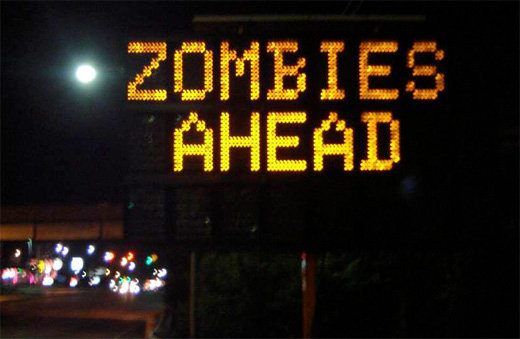
While it would be highly illegal, potentially unethical, and generally a very bad idea to hijack one of those blinking road signs, either as part of a thoughtful and considered public intervention or simply in the name of free-spirited high jinks (pictured), illustrated instructions for doing precisely that are available for perusal by the curious. [via the heretofore useless-to-me car blog, Jalopnik]
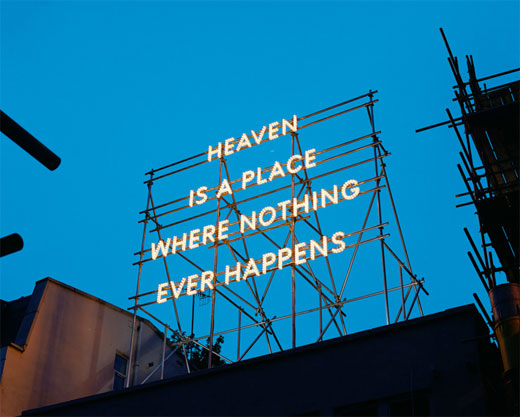
Nathan Coley – Heaven Is a Place Where Nothing Ever Happens (2008)
Since one of the recurring project ideas for BCL has been to “send a message to Detroit” (though this particular wording sounds decidedly menacing, which is hilarious and probably unintentional), and since one of the ideas for accomplishing this was to build a lighted sign that would be visible across the Detroit River, I thought it might be appropriate to bring Glaswegian artist Nathan Coley into the discussion.
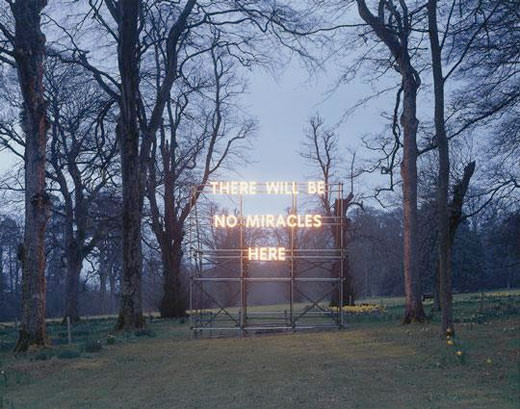
Nathan Coley – There Will Be No Miracles Here (2006)
Coley is perhaps best known for his incandescent light signs, such as these, and, while the tenor of his work is decidedly more dour than much of what the Lab sets out to do, his work does bring to bear certain issues that might be of interest. In particular, his work explores the ways in which modes of public address—particularly architecture—constitute articulations of collective desire and belief, the “values” of a place. Coley himself has a particular chip on his shoulder re: organized religion (which I, for one, appreciate), but some of the issues he works through might be more broadly-applicable, just the same.
If Broken City means to “disrupt and engage the city,” it’s important first to have a sense of what values are embodied in the existing structures and infrastructure of that city. I’m quite sure I’ve spent a good deal less time thinking about this than many of the other people here, but, so far as I can tell, Windsor’s public front would seem to suggest a firm conviction in the redemptive potential of (1) the automobile, (2) the Casino, (3) trans-border truck traffic, and (4) massage parlors. It’s not quite the historical God and country business that Coley contends with, but I don’t see any reason why the tactics he employs couldn’t be as well-suited to the interrogation of a strip mall as they are to places of worship, etc.
Anyway, this interview, given on the occasion of his nomination for the 2007 Turner Prize, is definitely worth a look, as are pieces like this one from 2006 where he makes use of dazzle camouflage (a geometric camouflage pattern developed in Britain by artist Norman Wilkinson and used extensively during World War I).
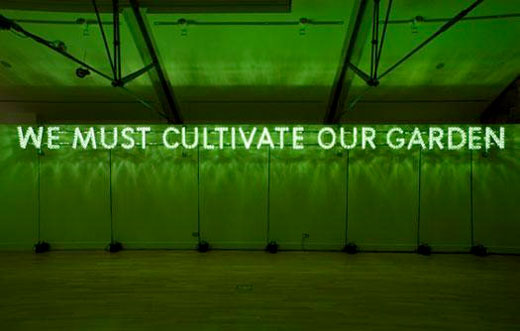
Nathan Coley – We Must Cultivate Our Garden (2007)
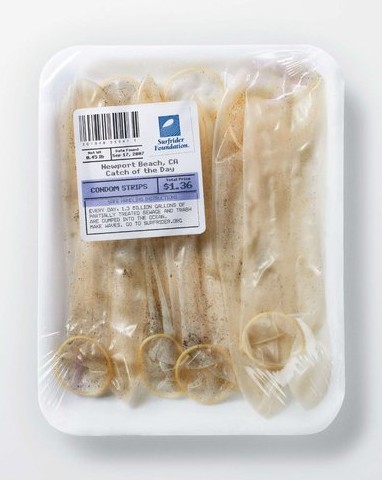
To bring attention to pollution, namely that of the ocean-type, Surfrider Foundation has created a delectable assortment of hand-harvested oceanic delights.
“…they collected actual trash from beaches around the U.S., packaged it like food, and left it on display at farmer’s markets. It’s site-specific, appropriate, impacting, meaningful, shocking, and an actual consumer insight into the very act they’re in the middle of. Someone about to buy fish from the same ocean as the trash in their hands can’t help but be at least a little more enlightened as to how pollution isn’t someone else’s problem.”
This led me to think: what do we actually harvest directly from the earth and market in Windsor besides salt? I don’t think I’ve lived “in” Windsor long enough to come up with an answer. Any ideas?
Note the sarcastic descriptions on the packages.
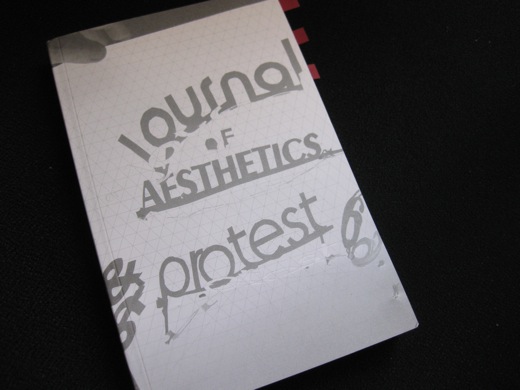
I recently got a copy of Issue 6 of the Journal of Aesthetics & Protest, based on a recommendation from WMMNA. I’m still making my way through it, but an article by Lisa Anne Auerbach entitled, “D.D.I.Y.: Don’t Do It Yourself,” really caught my attention.
Auerbach basically argues that D.I.Y. culture has been hijacked by corporations and their marketing departments and we’re not going to get it back anytime soon. What had started as a revolt against these very centers of consumption has been flipped on its head and is being sold back to us as a lifestyle brand. Auerbach goes on to issue a new battle cry, “D.D.I.Y,” noting that we only need to look as far as our neighbour’s garage for the tools or skills we need to complete a project (and in all likelihood, that neighbour is looking for some skill we have). In her words,
“[It] means working with friends, hiring a professional, consuming wisely and conscientiously, and providing for ourselves while working with others. We do what we do best, do what we know how to do, while allowing others to help us with what we are not equipped for.”
Of course, there are many things that can benefit from a D.I.Y. mindset—not the least of which include being able to get things done for yourself, but in a broader sense, I know there are a lot of people I see every week that can do things a lot better than I can, and in turn there are likely some things that I can do better than them. Why don’t I ask for their help more often (or offer my help for that matter)? I’m not entirely sure, but it’s something to start considering a bit more seriously.
You can read the entire article online.
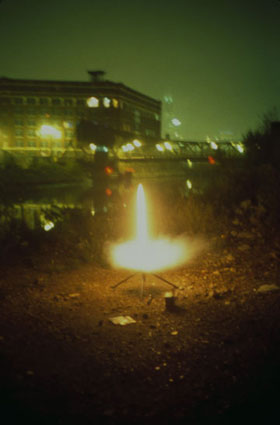
Like I had promised, here is another one of the Intermod Series projects titled: Low Altitude Atmospheric & Civic Modifications. I think it’s sort of beautifully sad in it’s futility and highlights a pretty important perspective that seems often ignored.
“This project used rockets with payloads to create micro-alterations of a city’s near atmospheric environment. There were 5 different payloads which when released into the air, propagated the designed effects determined by the use of therapeutics, noise and EMF screening, weather adjustment, and unusual optical events. The launch schedule was distributed over a 5-month period.”
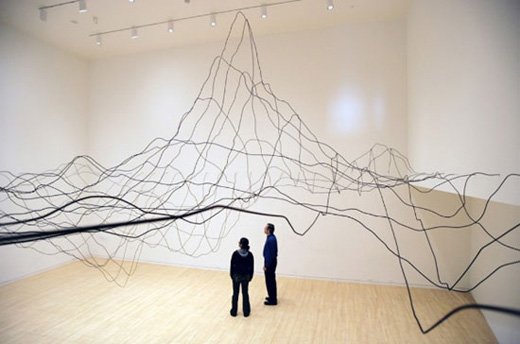
Maya Lin has created a number of public art works, memorials, and has increasingly shifted her practice towards studies of landscape, often rendering rivers, geographic relief, and water lines. Interestingly, many of her recent works are made exclusively of reclaimed materials—silver from jewelry, computers, and photographic process, and lumber from sustainably harvested wood.
There’s an interesting, but lengthy, video lecture by Maya Lin on the De Young Gallery website, where she explains a lot of her work and the processes behind it.
[via]
With our interest in mapping (and using the fancy technology of Google Maps to try to do so), I thought it might be interesting to post on this project, which is very much not about fancy technology. Katy Asher, a student in Portland’s MFA in Art and Social Practice program, along with Ariana Jacob and Amber Bell, have initiated a project that “aims to make a vending cart of maps made by people from Portland.”
This feels like an intersection of a number of projects we’ve discussed and are also ongoing in the community, and makes me wonder what subjective maps would look like for other Windsorites. Asking for people to map their routes to work, their favourite restaurants, their neighbourhoods would certainly provide an interesting look at the way distances and geography are collapsed or exaggerated and might help to discover some other broken parts of our city and the way it functions (or doesn’t).
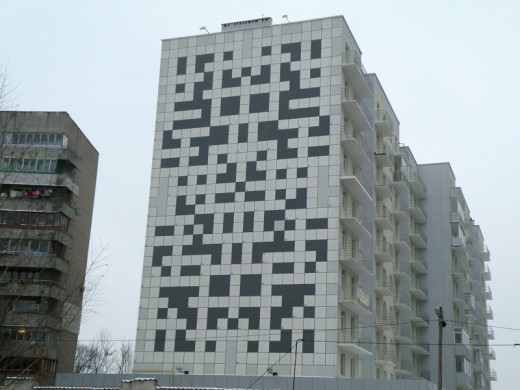
Across the city of Lvov, Ukraine, you’ll find clues for this giant crossword puzzle. At night, the answers become visible as a lightly glowing fluorescent colour.
[via]
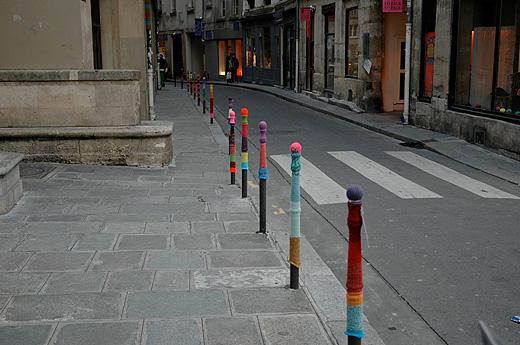
Knitta formed in 2005 out of frustration of unfinished knitting projects sitting around the house. Instead of trying to finish sweaters and mittens, they decided to go out and bomb the city’s infrastructure (and sometimes garbage) with yarn, starting with their hometown of Houston, Texas and eventually tagging the Great Wall of China. Above you can see a project they did in France. They’ve gotten a lot of mileage out of this project, though things seem to have slowed over the last year.
Anyways, it reminded me of that idea Michelle brought up about dressing up infrastructure in the city for Halloween.